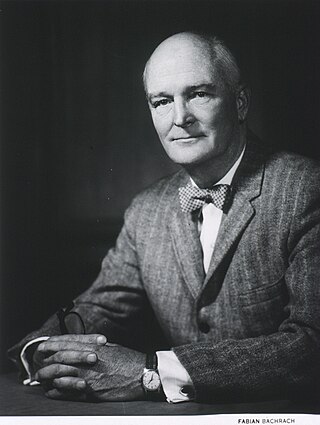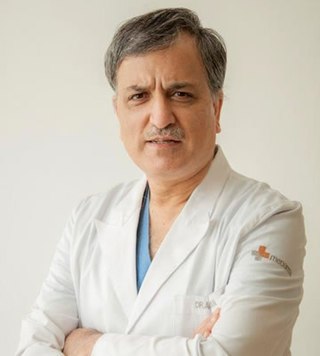
Cardiothoracic surgery is the field of medicine involved in surgical treatment of organs inside the thoracic cavity — generally treatment of conditions of the heart, lungs, and other pleural or mediastinal structures.

Cardiac surgery, or cardiovascular surgery, is surgery on the heart or great vessels performed by cardiac surgeons. It is often used to treat complications of ischemic heart disease ; to correct congenital heart disease; or to treat valvular heart disease from various causes, including endocarditis, rheumatic heart disease, and atherosclerosis. It also includes heart transplantation.

Daniel Hale Williams was an American surgeon and hospital founder. An African American, he founded Provident Hospital in 1891, which was the first non-segregated hospital in the United States. Provident also had an associated nursing school for African Americans. He is known for having completed the first successful heart surgery.

John Heysham Gibbon was an American surgeon best known for inventing the heart–lung machine and performing subsequent open-heart surgeries which revolutionized heart surgery in the twentieth century. He was the son of Dr. John Heysham Gibbon Sr., and Marjorie Young Gibbon, and came from a long line of medical doctors including his father, grandfather Robert, great-grandfather John and great-great grandfather.
Henry Clay Dalton was superintendent of the St. Louis City Hospital, Missouri, United States, from 1886 to 1892, and later a professor of abdominal and clinical surgery at Marion Sims College of Medicine. He is noted for being the first American to perform the suturing of the pericardium on record. Spanish surgeon Francisco Romero was documented with performing two successful surgeries in 1801 and French surgeon Dominique Jean Larrey was documented as successfully performing surgery on a woman's pericardium in 1810.
Alain Frédéric Carpentier is a French surgeon whom the President of the American Association for Thoracic Surgery calls the father of modern mitral valve repair. He is most well known for the development and popularization of a number of mitral valve repair techniques. In 1996, he performed the first minimally invasive mitral valve repair in the world and in 1998 he performed the first robotic mitral valve repair with the DaVinci robot prototype. He is the recipient of the 2007 Lasker Prize.

Vladimir Petrovich Demikhov was a Soviet Russian scientist and organ transplantation pioneer, who performed several transplants in the 1940s and 1950s, including the transplantation of a heart into an animal and a heart–lung replacement in an animal. He is also well known for his dog head transplants, which he conducted during the 1950s, resulting in two-headed dogs. This ultimately led to the head transplants in monkeys by Dr. Robert White, who was inspired by Demikhov's work.

Annuloaortic ectasia is characterized by pure aortic valve regurgitation and aneurysmal dilatation of the ascending aorta. Men are more likely than women to develop idiopathic annuloaortic ectasia, which usually manifests in the fourth or sixth decades of life. Additional factors that contribute to this condition include osteogenesis imperfecta, inflammatory aortic diseases, intrinsic valve disease, Loeys-Dietz syndrome, Marfan syndrome, and operated congenital heart disease.
The Kawashima procedure is used for congenital heart disease with a single effective ventricle and an interrupted inferior vena cava (IVC). It was first performed in 1978 and reported in 1984.

Clarence Crafoord was a Swedish cardiovascular surgeon, best known for performing the first successful repair of aortic coarctation on 19 October 1944, one year before Robert E. Gross. Crafoord also introduced heparin as thrombosis prophylaxis in the 1930s and he pioneered mechanical positive-pressure ventilation during thoracic operations in the 1940s.
Vessel harvesting is a surgical technique that may be used in conjunction with a coronary artery bypass graft (CABG). For patients with coronary artery disease, a physician may recommend a bypass to reroute blood around blocked arteries to restore and improve blood flow and oxygen to the heart. To create the bypass graft, a surgeon will remove or "harvest" healthy blood vessels from another part of the body, often from the patient's leg or arm. This vessel becomes a graft, with one end attaching to a blood source above and the other end below the blocked area, creating a "conduit" channel or new blood flow connection across the heart.
The Blalock–Hanlon procedure was created by Alfred Blalock and C. Rollins Hanlon. It was described in 1950. Alfred Blalock was an American surgeon most known for his work on the Blue Baby syndrome. C. Rollins Hanlon was also an American surgeon but was best known for his work in cardiology. The procedure that these two men created, known as the Blalock–Hanlon procedure, was a new concept termed atrial septectomy. This procedure had been experimented on the right atrium of dogs before Dr. Blalock and Dr. Hanlon had performed it on humans.

The Society of Thoracic Surgeons is a Chicago, Illinois (US)-based medical specialty professional society in the field of cardiothoracic surgery. Membership worldwide includes more than 7,500 surgeons, researchers, and other health care professionals who are part of the cardiothoracic surgery team. The Society's official journal is The Annals of Thoracic Surgery.

Open aortic surgery (OAS), also known as open aortic repair (OAR), describes a technique whereby an abdominal, thoracic or retroperitoneal surgical incision is used to visualize and control the aorta for purposes of treatment, usually by the replacement of the affected segment with a prosthetic graft. OAS is used to treat aneurysms of the abdominal and thoracic aorta, aortic dissection, acute aortic syndrome, and aortic ruptures. Aortobifemoral bypass is also used to treat atherosclerotic disease of the abdominal aorta below the level of the renal arteries. In 2003, OAS was surpassed by endovascular aneurysm repair (EVAR) as the most common technique for repairing abdominal aortic aneurysms in the United States.
Floyd John Lewis was an American surgeon who performed the first successful open heart operation, closing an atrial septal defect in a 5-year-old girl, on 2 September 1952. For the next 3 years, Lewis and colleagues operated on 60 patients with atrial septal defects using hypothermia and inflow occlusion. He was best friends with C. Walton Lillehei and they worked together at the University of Minnesota.

Nina Starr Braunwald was an American thoracic surgeon and medical researcher who was among the first women to perform open-heart surgery. She was also the first woman to be certified by the American Board of Thoracic Surgery, and the first to be elected to the American Association for Thoracic Surgery. In 1960, at the age of 32, she led the operative team at the U.S. National Institutes of Health (NIH) that implanted the first successful artificial mitral human heart valve replacement, which she had designed and fabricated.

The Eloesser flap is a surgical procedure developed by Dr. Leo Eloesser in 1935 at the San Francisco General Hospital. It was originally intended to aid with drainage of tuberculous empyemas, since at the time there were no effective medications to treat tuberculosis. The procedure was used extensively until the development of effective chemotherapy for tuberculosis in the late 1940s and early 1950s. It is still used occasionally for chronic empyemas.
Vasilii Ivanovich Kolesov was one of the pioneers of global cardiac surgery. He was the first to perform successful internal coronary artery bypass surgery using mammary artery–coronary artery anastomosis in 1964. Also in 1964, he performed the first successful coronary bypass using a standard suture technique. Kolesov was a recipient of the USSR State Prize and Honoured Worker of Science of the RSFSR (1964).
Philip Caves (1940–1978) was a Northern Irish cardiothoracic surgeon. In 1972, while at Stanford University, he pioneered the use of the bioptome and transvenous endomyocardial biopsy in the early diagnosis of heart transplant rejection. It was considered the most significant advance in antirejection therapy of the time. Awarded the British American Research Fellowship in 1971, Caves worked with pioneering cardiothoracic surgeon Norman Shumway at Stanford and became staff surgeon leading the transplant programme by 1973. A year later he went to Edinburgh as a senior lecturer in cardiac surgery, where he became particularly interested in pediatric cardiac surgery.

Dr. Anil Bhan is the Chairman of Cardiac Surgery Heart Institute, Medanta Hospital, Gurugram, India. He graduated from Medical College Srinagar. He has the largest experience in aortic surgery in India since he has designed and developed more than 50 surgical instruments in the field of cardiac surgery. He was one of the team members to perform the first successful heart transplant in India in1994. He served as a co-founder of Max Heart and Vascular Institute, Saket, New Delhi, Director and Chief Co-Ordinator, Cardio thoracic and Vascular Surgery, MHVI, Saket.Additional Professor, Cardiothoracic Surgery and Vascular Surgery, AIIMS, New Delhi.









